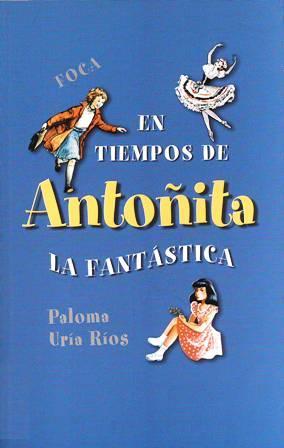Several children's programs were aired during the regime of Ferdinand Franco, the Spanish dictator who won when the Communists and the Nazis were vying for control over Spain in 1936. During his reign, kids did not have their own programming. Children were instead known as young adults and could only watch the television during a limited schedule, on one channel, and content was family friendly. For the first time, a study has analyzed 112 children's programs broadcast between 1958 and 1975, concluding that the aim was to religiously and patriotically educate children; and later, focusing on the social and economical situation of the country.
The dividing advertisement, Vamos a la cama (1964 - 'It's time to go to bed') was a turning point for children's programs. Family programs were transmitted up until that time. The advertisement just marked a limit for young audiences, nothing else: "adult programs were still relayed during the afternoon," explains María Antonia Paz, researcher at the department of History of Social Communication in the Information Sciences Faculty at the Complutense University of Madrid to SINC.
 The fantastic Antonia character exerted power over girls under Franco. Credit BNE
The fantastic Antonia character exerted power over girls under Franco. Credit BNE
The first children's programs were broadcast in accordance with school timetables, that is to say, on Thursday and Saturday afternoons when children didn't have class. It was not until 1964 when the airing times for children's programs increased during the weekdays.
Children's programs were at the mercy of the dictatorship
The different types of programs shown during the Franco regime coincided with the "attempt to teach children to be good citizens," highlights professor Paz. According to the author, Catholicism was directly present in Lecciones de catecismo (1959 - 'Lessons on how to prepare for the Catechesis') and, indirectly in "each and every one of the means through parabolas, education, recommendations, etc".
Patriotism was spread by means of exemplary lives: "Spaniards, of both the present and the past, should be a benchmark for all good Spaniards professionally and personally. Examples were always provided in order to show that Spanish inventions, sport, music triumphed all over the world," added the researcher.
Tradition overpowered modern ideals in this period: folk music, fables, children's songs, classical tales, regional dances, traditional games, circus, puppets... "It was as if the television aimed to maintain and spread the word on popular culture and convey a television culture," remarks Paz.
The aforesaid observations and conclusions were gathered in the study, published in the 'European Journal of Communication', by María Antonia Paz. 122 children's program transmitted on TVE (Spanish National Television) from 1958 -when information media on television programs started to appear- until the 20th November 1975 -after Franco passed away- were analyzed.
According to the study, the main aim of TVE was to entertain children, although they did not miss the opportunity to "educate" children with scientific or musical contents. However, children's programs prepared its audience for the volatile economical uncertainty as well as the industrialization, urbanization and cultural modifications within the country, with a certain degree of liberalization after the end of the Franco regime.
'Not suitable for adults'
In 1959, children's programs started with No apto para mayores ('Not suitable for adults'), which was broadcast on Saturdays. Recreo (1960 - 'Break') and Chavales (1961 - 'Kids') were more successful and entertained both children and adults on Thursday afternoons. The main characters -Boliche and Chapinete - started their careers on the radio and later prevailed on the television.
From 1958 to 1963, "children were considered as small fry, young adults and, they were conferred small problems and worries, similar to what adults could experience," emphasizes Professor María Antonia Paz. The formats changed little by little: from imitating radio programs to creating new means adapted to the television.
From 1964, the 55 second advertisement Vamos a la cama marked a milestone: children became a differentiated audience. During this period, programs began to be distinguished with regard to age. Jardilín (1966-1968 - 'Little garden'), for instance, was for younger children. There were two types of programs for teenagers: the first to solve problems such as Habla contigo (1967-1970 - 'Speak to yourself'), which rose awareness on religious conflicts and the second to listen to modern music.
There were also gender differences such as Santi, botones de hotel (1965 - 'Santi, the hotel bellboy') which was about a brave, adventurous, daring young boy. Antoñita la fantástica (1967 - 'Fantastic Antonia'), was a girls program about "a modern ingenious girl who was concerned about her physical appearance and full of fantasies," describes the researcher. There were other foreign boy's series such as the western "Bonanza", which was highly popular among children back then.
From 1969 to 1975, TVE focused on pure entertainment and educational and religious programs disappeared as a consequence of the law on religious freedom in 1967. "Television joined the cause for modernization and reflected the new social and economical reality of the country," highlights the authors.
The most successful program was emitted for four years (from 1974 to 1979). It was called Un globo, dos globos, tres globos ('One balloon, two balloons, and three balloons'). This program and 'Sesame Street' reached new levels with regard to children's programs. "The latter and other programs, such as Con vosotros ('With you all'), were the daily television offer for some time. La Guagua ('The bus') was aired in the mornings and Saturday evenings were for children. On Sundays, primarily sports programs were transmitted," remarks Paz.
According to the author, "these programs were the first and the only memory of various generations of Spanish television which entertained and, socially, culturally and emotionally educated its audience with its programs, presenters and characters.
Reference: Paz, María Antonia; Martínez, Lizette "Children's programming on Television Espanola under Franco (1958-1975)" European Journal of Communication 29(4): 465-479 (2014) DOI: 10.1177/0267323114530359